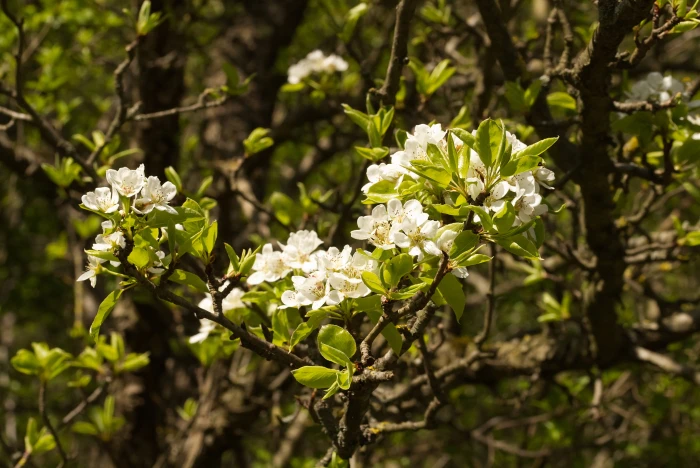European Wild Pear
(Pyrus pyraster)
European Wild Pear (Pyrus pyraster)
/
/

© David Sandler
CC BY 4.0
Image By:
© David Sandler
Recorded By:
Copyright:
CC BY 4.0
Copyright Notice:
Photo by: © David Sandler | License Type: CC BY 4.0 | License URL: http://creativecommons.org/licenses/by/4.0/ | Uploader: davidsandler | Publisher: iNaturalist |

























Estimated Native Range
Climate Requirements
| • Precipitation | 10" - 74" |
| • High Temp. | 55°F - 97°F |
| • Low Temp. | 2°F - 46°F |
Summary
Pyrus pyraster, commonly known as European wild pear, is a deciduous tree or large shrub native to a variety of habitats including open woodlands, forest edges, and hedgerows across Europe and western Asia. As a shrub, it typically reaches 10-13 feet, while as a tree it can grow up to 66 feet tall. The European wild pear is characterized by its rounded to oval crown, gray-brown bark, and glossy green leaves that turn yellow in the fall. In spring, it produces showy clusters of white flowers, followed by small, hard, astringent fruits that are edible but not particularly palatable when raw.
The European wild pear is valued for its ornamental flowers and its potential as a genetic resource for pear breeding programs. It is also appreciated for its wildlife value, as its fruits provide food for birds and other animals. In cultivation, it prefers well-drained soils, tolerates a range of soil types, and requires full sun to part shade. It is used in reforestation projects, as a genetic resource for pear breeding, and occasionally for its wood. While generally disease-resistant, it can be susceptible to fire blight and other common pear diseases. It is not known for being invasive outside its native range, but care should be taken to avoid the spread of diseases to domestic pear varieties.CC BY-SA 4.0
The European wild pear is valued for its ornamental flowers and its potential as a genetic resource for pear breeding programs. It is also appreciated for its wildlife value, as its fruits provide food for birds and other animals. In cultivation, it prefers well-drained soils, tolerates a range of soil types, and requires full sun to part shade. It is used in reforestation projects, as a genetic resource for pear breeding, and occasionally for its wood. While generally disease-resistant, it can be susceptible to fire blight and other common pear diseases. It is not known for being invasive outside its native range, but care should be taken to avoid the spread of diseases to domestic pear varieties.CC BY-SA 4.0
Plant Description
- Plant Type: Trees
- Height: 10-50 feet
- Width: 13-23 feet
- Growth Rate: Moderate
- Flower Color: White
- Flowering Season: Spring
- Leaf Retention: Deciduous
Growth Requirements
- Sun: Full Sun, Part Shade
- Water: Medium
- Drainage: Fast, Medium
Common Uses
Bee Garden, Bird Garden, Edible*Disclaimer: Easyscape's listed plant edibility is for informational use. Always verify the safety and proper identification of any plant before consumption., Low Maintenance, Showy Flowers
Natural Habitat
Open woodlands, forest edges, and hedgerows across Western Europe and the Caucasus region
Other Names
Common Names: Wild Pear , European Wild Pear
Scientific Names: Pyrus pyraster , Pyrus achras , Pyrus achras subsp. pyraster , Pyrus achras subsp. pyraster , Pyrus achras var. glabra , Pyrus achras var. pyraster , Pyrus achras var. tomentosa , Pyrus boreana , Pyrus brachypoda , Pyrus brachypoda
GBIF Accepted Name: Pyrus pyraster